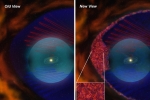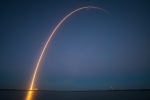Coolest Science Photos Of 2013: From Blobfish To Two-Headed Shark, Comet ISON To Mars Selfie
Sometimes science isn't interesting because it doesn't make any sense. Sure, there's somebody in Cambridge, Mass., who gets amped on quantum physics breakthroughs, but you and me and the guy at the deli across the street want to know when they're coming out with teleportation.
But sometimes science hits even the densest of us hard, turning us back into little kids, sitting in class, listening to the teacher tell us why volcanos spit lava and the moon changes shapes. That's kind of what the photos are for. They let the MIT physicist and the deli guy get excited about the same thing. We've picked out a few of our favorites from 2013. And not just earth and space science, but biology and technology, too. It's been an interesting year.
Like Us on Facebook
In November, SpaceX launched its first commercial satellite into orbit, solidifying the company's stake in the space transit industry. People in Broward County, 170 miles south of Cape Canaveral, Fla., said they could see the rocket streak out over the ocean."

NASA released a dazzling picture of what it called "the jewel of the solar system," Saturn. It's a gorgeous view of the rings, spanning more than 400,000 miles of space. The planet appears black because it's eclipsing the sun for the space probe Cassini, which took the picture. The coolest part is that earth and our moon appear in the bottom right quadrant, nearly microscopic in the background. Click here to see the photo in high resolution and labeled.

Earlier this year, Alaska and Canada were treated to the sun's ions dancing in the grips of the earth's magnetism. A man hiking outside Fairbanks, Alaska, snapped this picture.

In other news, scientists confirmed the discovery of the first ever two-headed bull shark. A fisherman who caught a mother found this mutant fetus in her uterus. It quickly died, but scientists say it probably would've died just as quickly in the wild.

The comet ISON (RIP) pretty much dissolved as it passed by the sun earlier this month. But before it died, NASA's Hubble Space Telescope captured this awesome picture of the comet and everything behind it. By focusing the lens on the stars and galaxies in the background, ISON is blurred. But, honestly, pictures of tiny spiral galaxies are way cooler.

Curiosity, NASA's Mars rover, discovered an ancient freshwater lake and the possibility of lifeforms there, scientists announced this month. But one of the first things it did was take a self portrait for inspection (and maybe vanity) purposes.

In September, Europe's most active volcano, Mt. Etna, erupted, sending bright orange lava into the night sky and waking up the neighbors for miles around.

Then, in November, another volcano erupted, this time half a world away near the Mariana Trench in the Pacific Ocean. It added new earth to a string of Japanese islands.

OK, don't look at this next one for too long or while eating. It's called the blobfish, spawned in the graciously dark waters deep off the coast of Australia. In September, the Ugly Animal Preservation Society awarded it the distinction: "world's ugliest animal." As you can see, blobfish here was none too pleased.

Nikon, the camera maker, again held its "Small World" competition for awesome pictures of microscopic things. The winner, Wim von Egmond, took a picture of a marine diatom, a helix-shaped oxygen-producing organism. He found this one on plankton in the North Sea. See all the top entries here.

This is what it looks like when a star dies. A new image taken by the Very Large Telescope in Chile shows the deep reddish hues of a the matter left from a supernova explosion, the great last gasp of a star. This entire nebular cloud is 14,000 lightyears across and is located 160,000 lightyears away from earth.

This baby is called the Zumwalt Stealth Destroyer, one of the Navy's latest and quietest toys. The ship was floated off its dry docks in October, when this photo was taken. The Navy says its 007 appearance are less for aesthetics than for stealth. Radio waves bounce off the ship at odd angles, making it difficult for radars to detect.

© 2012 iScience Times All rights reserved. Do not reproduce without permission.

25 Year Study Reveals Eco-Farming To Be Economically Feasible And Sustainable

How Methane-Producing Microbes Caused The Largest Mass Extinction The World Has Ever Seen

Terrifying Animatronic Robot Dances To 'Blurred Lines,' Causes Nightmares [VIDEO]

Scientists Demonstrate Three-Way Quantum Communication: What's Faster Than The Speed Of Light?

Woolly Mammoth DNA To Be Cloned, Then Joined With Elephant DNA To Create New Creature

Oculus Rift Headset Will Take You On A Trip To Space, All From The Comfort Of Your Couch



![How to Turn Your Tap Water Faucet Into a Coffee Spout [VIDEO]](../../../cdn-sub/data/thumb/mainpage/6005-150100-coffee.jpg)

